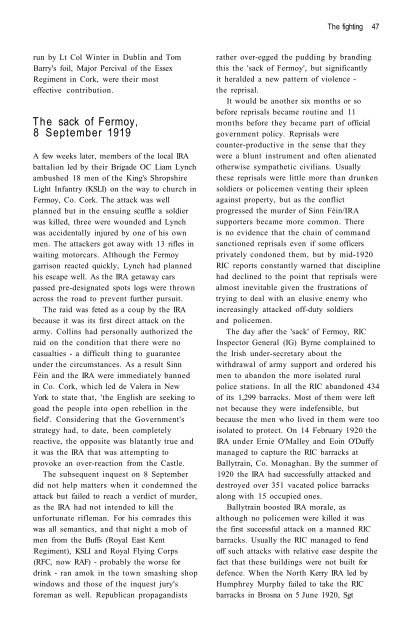Create successful ePaper yourself
Turn your PDF publications into a flip-book with our unique Google optimized e-Paper software.
<strong>The</strong> fighting 47<br />
run by Lt Col Winter in Dublin and Tom<br />
Barry's foil, Major Percival of the Essex<br />
Regiment in Cork, were their most<br />
effective contribution.<br />
<strong>The</strong> sack of Fermoy,<br />
8 September 1919<br />
A few weeks later, members of the local IRA<br />
battalion led by their Brigade OC Liam Lynch<br />
ambushed 18 men of the King's Shropshire<br />
Light Infantry (KSLI) on the way to church in<br />
Fermoy, Co. Cork. <strong>The</strong> attack was well<br />
planned but in the ensuing scuffle a soldier<br />
was killed, three were wounded and Lynch<br />
was accidentally injured by one of his own<br />
men. <strong>The</strong> attackers got away with 13 rifles in<br />
waiting motorcars. Although the Fermoy<br />
garrison reacted quickly, Lynch had planned<br />
his escape well. As the IRA getaway cars<br />
passed pre-designated spots logs were thrown<br />
across the road to prevent further pursuit.<br />
<strong>The</strong> raid was feted as a coup by the IRA<br />
because it was its first direct attack on the<br />
army. Collins had personally authorized the<br />
raid on the condition that there were no<br />
casualties - a difficult thing to guarantee<br />
under the circumstances. As a result Sinn<br />
Féin and the IRA were immediately banned<br />
in Co. Cork, which led de Valera in New<br />
York to state that, 'the English are seeking to<br />
goad the people into open rebellion in the<br />
field'. Considering that the Government's<br />
strategy had, to date, been completely<br />
reactive, the opposite was blatantly true and<br />
it was the IRA that was attempting to<br />
provoke an over-reaction from the Castle.<br />
<strong>The</strong> subsequent inquest on 8 September<br />
did not help matters when it condemned the<br />
attack but failed to reach a verdict of murder,<br />
as the IRA had not intended to kill the<br />
unfortunate rifleman. For his comrades this<br />
was all semantics, and that night a mob of<br />
men from the Buffs (Royal East Kent<br />
Regiment), KSLI and Royal Flying Corps<br />
(RFC, now RAF) - probably the worse for<br />
drink - ran amok in the town smashing shop<br />
windows and those of the inquest jury's<br />
foreman as well. Republican propagandists<br />
rather over-egged the pudding by branding<br />
this the 'sack of Fermoy', but significantly<br />
it heralded a new pattern of violence -<br />
the reprisal.<br />
It would be another six months or so<br />
before reprisals became routine and 11<br />
months before they became part of official<br />
government policy. Reprisals were<br />
counter-productive in the sense that they<br />
were a blunt instrument and often alienated<br />
otherwise sympathetic civilians. Usually<br />
these reprisals were little more than drunken<br />
soldiers or policemen venting their spleen<br />
against property, but as the conflict<br />
progressed the murder of Sinn Féin/IRA<br />
supporters became more common. <strong>The</strong>re<br />
is no evidence that the chain of command<br />
sanctioned reprisals even if some officers<br />
privately condoned them, but by mid-1920<br />
RIC reports constantly warned that discipline<br />
had declined to the point that reprisals were<br />
almost inevitable given the frustrations of<br />
trying to deal with an elusive enemy who<br />
increasingly attacked off-duty soldiers<br />
and policemen.<br />
<strong>The</strong> day after the 'sack' of Fermoy, RIC<br />
Inspector General (IG) Byrne complained to<br />
the <strong>Irish</strong> under-secretary about the<br />
withdrawal of army support and ordered his<br />
men to abandon the more isolated rural<br />
police stations. In all the RIC abandoned 434<br />
of its 1,299 barracks. Most of them were left<br />
not because they were indefensible, but<br />
because the men who lived in them were too<br />
isolated to protect. On 14 February 1920 the<br />
IRA under Ernie O'Malley and Eoin O'Duffy<br />
managed to capture the RIC barracks at<br />
Ballytrain, Co. Monaghan. By the summer of<br />
1920 the IRA had successfully attacked and<br />
destroyed over 351 vacated police barracks<br />
along with 15 occupied ones.<br />
Ballytrain boosted IRA morale, as<br />
although no policemen were killed it was<br />
the first successful attack on a manned RIC<br />
barracks. Usually the RIC managed to fend<br />
off such attacks with relative ease despite the<br />
fact that these buildings were not built for<br />
defence. When the North Kerry IRA led by<br />
Humphrey Murphy failed to take the RIC<br />
barracks in Brosna on 5 June 1920, Sgt



